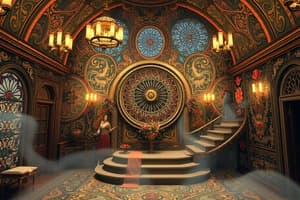Podcast
Questions and Answers
What does the slope of a distance-time graph represent?
What does the slope of a distance-time graph represent?
- Time
- Distance
- Acceleration
- Velocity (correct)
What is the rate of change of velocity?
What is the rate of change of velocity?
- Velocity
- Retardation
- Acceleration (correct)
- Deceleration
What is retardation?
What is retardation?
- Zero acceleration
- Negative acceleration (correct)
- Positive acceleration
- Constant velocity
What is the acceleration of an object in uniform motion?
What is the acceleration of an object in uniform motion?
What is an example of non-uniform motion?
What is an example of non-uniform motion?
What does the slope of a velocity-time graph represent?
What does the slope of a velocity-time graph represent?
What is the characteristic of the acceleration of an object in non-uniform motion?
What is the characteristic of the acceleration of an object in non-uniform motion?
Flashcards are hidden until you start studying
Study Notes
Graphical Representation
- A straight line motion can be represented graphically using a distance-time graph and a velocity-time graph.
- Distance-time graph:
- Slope of the graph represents velocity.
- Steeper slope indicates higher velocity.
- Velocity-time graph:
- Slope of the graph represents acceleration.
- Positive slope indicates acceleration, negative slope indicates deceleration.
Acceleration
- Acceleration is the rate of change of velocity.
- It is a vector quantity, measured in m/s².
- Acceleration can be positive (increasing velocity) or negative (decreasing velocity).
Retardation
- Retardation is the rate of decrease in velocity.
- It is a type of deceleration.
- Retardation is a negative acceleration.
Non-uniform Motion
- Non-uniform motion is when the velocity of an object changes with time.
- The acceleration of an object in non-uniform motion is not constant.
- Examples: a car accelerating from rest, a thrown ball.
Uniform Motion
- Uniform motion is when the velocity of an object remains constant.
- The acceleration of an object in uniform motion is zero.
- Examples: a car moving at a constant speed, a satellite in orbit.
Graphical Representation
- A distance-time graph and a velocity-time graph can be used to represent straight line motion graphically.
- The slope of a distance-time graph represents velocity, and a steeper slope indicates higher velocity.
- The slope of a velocity-time graph represents acceleration, with a positive slope indicating acceleration and a negative slope indicating deceleration.
Acceleration
- Acceleration is the rate of change of velocity and is a vector quantity measured in m/s².
- Acceleration can be positive (increasing velocity) or negative (decreasing velocity).
Retardation
- Retardation is the rate of decrease in velocity and is a type of deceleration.
- Retardation is a negative acceleration.
Motion
Non-uniform Motion
- Non-uniform motion occurs when the velocity of an object changes with time.
- The acceleration of an object in non-uniform motion is not constant.
- Examples of non-uniform motion include a car accelerating from rest and a thrown ball.
Uniform Motion
- Uniform motion occurs when the velocity of an object remains constant.
- The acceleration of an object in uniform motion is zero.
- Examples of uniform motion include a car moving at a constant speed and a satellite in orbit.
Studying That Suits You
Use AI to generate personalized quizzes and flashcards to suit your learning preferences.




